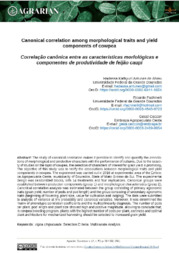Canonical correlation among morphological traits and yield components of cowpea.
Canonical correlation among morphological traits and yield components of cowpea.
Author(s): ABREU, H. K. A. de; FACHINELLI, R.; CECCON, G.
Summary: The study of canonical correlation makes it possible to identify and quantify the associa-tions of morphological and productive characters with the performance of cultures. Due to the scarci-ty of studies on the topic of cowpea, the selection of characters of interest for grain yield is promising. The objective of this study was to verify the associations between morphological traits and yield components in cowpea. The experiment was carried out in 2016 at experimental area of the Embra-pa Agropecuária Oeste, municipality of Dourados, State of Mato Grosso do Sul. The experimental design was randomized blocks, with 14 treatments and four replications. Canonical groups were established between production components (group 1) and morphological characteristics (group 2). Canonical correlation analysis was estimated between the group consisting of primary agronomic traits (grain yield, number of pods and pod length) and the group consisting of secondary agronomic traits (beginning of flowering, plant size, value for cultivation and lodging). The data were submitted to analysis of variance at 5% probability and canonical variables. Moreover, it was determined the matrix of phenotypic correlation coefficients and the multicollinearity diagnosis. The number of pods per plant, pod length and plant size showed high and positive magnitude, allowing to conclude that, in cowpea breeding program, plants with the highest number of pods per plant, earliness and optimal plant architecture for mechanized harvesting should be selected to increased grain yield
Publication year: 2021
Types of publication: Journal article
Keywords: Caracteres morfológicos, Caracteres produtivos, Feijão caupi
Observation
Some of Embrapa's publications are published as ePub files. To read them, use or download one of the following free software options to your computer or mobile device. Android: Google Play Books; IOS: iBooks; Windows and Linux: Calibre.
Access other publications
Access the Agricultural Research Database (BDPA) to consult Embrapa's full library collection and records.
Visit Embrapa Bookstore to purchase books and other publications sold by Embrapa.

